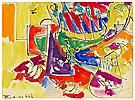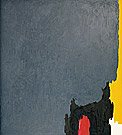New York School
The radical painters who worked in New York City during the 1940s and 1950s are known collectively as Abstract Expressionists or the New York School. Characterised by a spirit of revolt and aggressive self-determination, they shared a similar outlook rather than a cohesive style. The New York School is regarded as the first major American art movement, and its development marks the waning of Paris as the centre of the art world.
Abstract Expressionism has its roots in the social and artistic climate of the 1920s and 1930s, a period dominated by social realism and regionalism. The European émigrés to the United States who escaped the horrors of Nazism and World War II included Hans Hofmann, who founded an art school in New York in 1934. He influenced generations of younger artists from Clyfford Still to John Seery, and was known for his defence of abstraction, automatic painting and innovative techniques such as dribbled and ‘pulled’ paint. Willem de Kooning was another immigrant who also contributed to this lively cultural milieu.
In New York, the newly-established Museum of Modern Art and the Museum of Non-Objective Art (now Guggenheim), offered artists diverse opportunities to assimilate outside developments. Arshile Gorky’s works show the impact of Surrealism, especially the influence of Pablo Picasso. Mark Rothko retains Surrealist elements in Multiform 1948, while his later canvas, suffused with paint, anticipates Colour-field painting.













